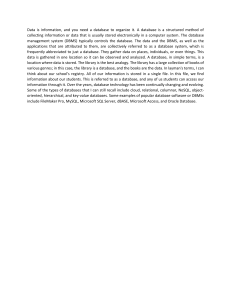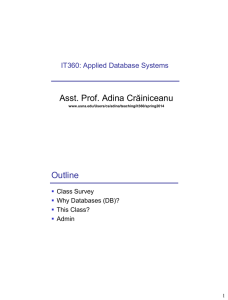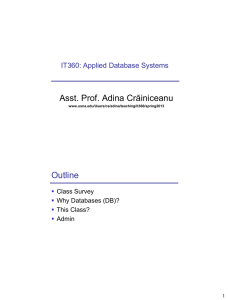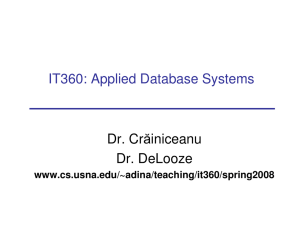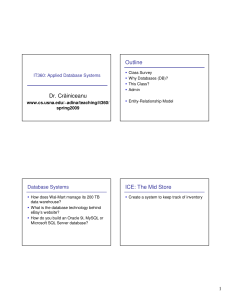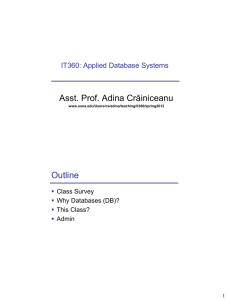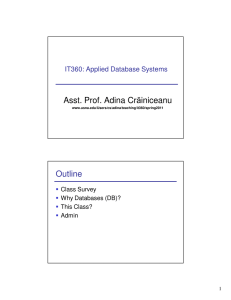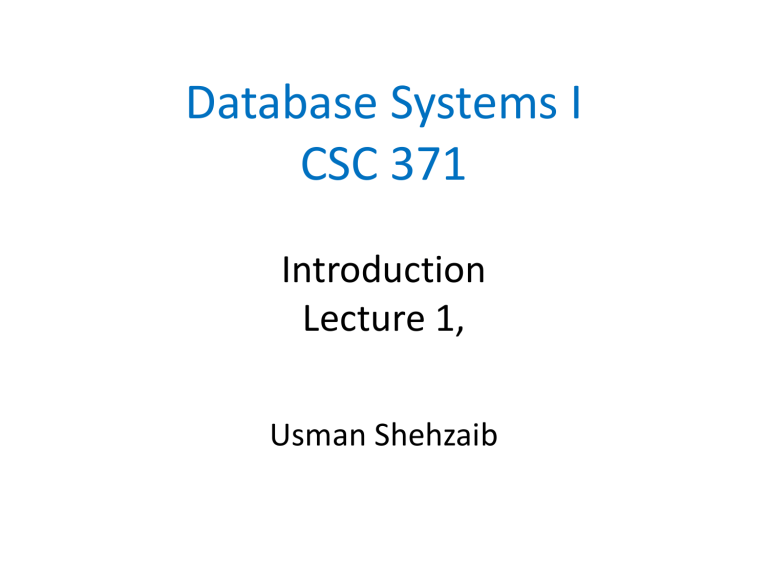
Database Systems I CSC 371 Introduction Lecture 1, Usman Shehzaib Today… Motivation Course overview Introduction to databases and database systems Outline Motivation Course Overview and Administrivia A Primer on Databases On the Verge of A Disruptive Century: Breakthroughs Gene Sequencing and Biotechnology Ubiquitous Computing Smaller, Faster, Cheaper Sensors Faster Communication A Common Theme is Data The amount of data is only growing… 1.2 Zettabytes (1ZB = 1021 B or 1 Billion TB) in 2010 We Live in a World of Data Nearly 500 Exabytes per day are generated by the Large Hadron Collider experiments (not all recorded!) 2.9 million emails are sent every second 20 hours of video are uploaded to YouTube every minute 24 PBs of data are processed by Google every day 50 million tweets are generated per day 700 billion total minutes are spent on Facebook each month 72.9 items are ordered on Amazon every second Data and Big Data The value of data as an organizational asset is widely recognized Data is literally exploding and is occurring along three main dimensions • “Volume” or the amount of data • “Velocity” or the speed of data • “Variety” or the range of data types and sources What is Big Data? It is the proliferation of data that floods organizations on a daily basis It is high volume, high velocity, and/or high variety information assets It requires new forms of processing to enable fast mining, enhanced decision-making, insight discovery and process optimization What Do We Do With Data and Big Data? Store Share Query Mine Encrypt …. and more! We want to do these seamlessly and fast... Using Diverse Interfaces & Devices Mobile Devices Computers …and even appliances Consumer Electronics Personal Monitors and Sensors We also want to access, share and process our data from all of our devices, anytime, anywhere! Data is Becoming Critical to Our Lives Health Education Science Domains of Data Environment Work Finance … and more Database Prehistory Data entry Query processing Storage and retrieval Sorting 11 Early Automation • Data management and application code were all tangled together – Hard to modify – Hard to generalize • Many competing approaches • Data manipulation code written at very low levels of abstraction 12 Our Hero --- E. F. Codd Edgar F. "Ted" Codd ( August 23, 1923 - April 18, 2003) was a British computer scientist who invented relational databases while working for IBM. He was born in Portland, Dorset, studied maths and chemistry at Oxford. He was a pilot in the Royal Air Force during WWII. In 1948 he joined IBM in New York as a mathematical programmer. He fled the USA to Canada during the McCarthy period. Later, he returned to the USA to earn a doctorate in CS from the University of Michigan in Ann Arbor. He then joined IBM research in San Jose. His 1970 paper “A Relational Model of Data for Large Shared Data Banks” changed everything. In the mid 1990’s he coined the term OLAP. 13 Why Studying Databases? Data is everywhere and is critical to our lives Data need to be recorded, maintained, accessed and manipulated correctly, securely, efficiently and effectively Database management systems (DBMSs) are indispensable software for achieving such goals The principles and practices of DBMSs are now an integral part of computer science curricula They encompass OS, languages, theory, AI, multimedia, and logic, among others As such, the study of database systems can prove to be richly rewarding in more ways than one! Outline Motivation Course Overview and Administrivia A Primer on Databases Course Objectives In this course we aim at studying: How to design and implement databases from scratch How to query and manipulate databases Application-Centric How to refine and speed up data retrieval and manipulation How to construct buffer and disk space managers, query optimizers, and concurrency and crash recovery managers for DBMSs Systems-Centric & Theory-Centric Big Data, BigTable, parallel and distributed DBMSs, NoSQL Advanced Topics (A Brief Overview depends List of Topics Considered: a reasonably critical and comprehensive understanding. Thoughtful: fluent, flexible and efficient understanding. Masterful: a powerful and illuminating understanding. .1. The Entity-Relationship Model .2. The Relational Model .3. Relational Algebra and Calculus .4. SQL .5. Data Storage and Organization .6. Tree-Based and Hash-Based Indexing .7. Query Evaluation and Optimization .9. Concurrency Control and Crash Recovery .10. Advanced Topics: Distributed Databases, NoSQL Learning Outcomes After finishing this course you will be able to: 1. Describe a wide range of data involved in real-world organizations using the entityrelationship (ER) data model 2. Explain how to translate an ER diagram into a relational database 3. Analyze and apply a formal query language, relational calculus and algebra 4. Indicate how SQL builds upon relational calculus and algebra and effectively apply SQL to create, query and manipulate relational databases 5. Design and develop multi-tiered, full-fledged standalone and web-based applications with back-end databases 6. Appreciate how DBMSs create, manipulate and manage files of fixed-length and variable-length records on disks Learning Outcomes After finishing this course you will be able to: 7. Create and operate various static and dynamic tree-based (e.g., B+ trees) and hashbased (e.g., extendable and linear hashing) indexing schemes 8. Explain and evaluate various algorithms for relational operations (e.g., join) using techniques such as iteration, indexing and partitioning 9. Analyze and apply different query evaluation plans and describe the various tasks of a typical relational query optimizer 10. Describe how transactions can be interleaved correctly, and indicate how a DBMS can ensure atomicity and durability when systems fail or entirely crash 11. Identify alternative architectures for distributed databases, and describe how data can be partitioned and distributed across networked nodes of a DBMS 12. Appreciate the scale of Big Data, discuss some popular analytics engines for Big Data processing and denote the applicability of NoSQL databases for Big Data storage Teaching Methods, Assignments and Projects 30 Lectures • Motivate learning • Provide a framework or roadmap to organize the information of the course • Explain subjects and reinforce the critical big ideas 4 Quiz • Get you to reveal what you do not understand, so we can help you 4 Assignments • We will have 4 assignments which involve problem solving and span most of the topics that we discuss in the class Projects • We will have a project which involve My SQL Server Learning Material & Resources Textbook & Reference Books: • Database Systems A practical Approach to Design, Implementation, and Management (Latest edition) By Thomas M. Connolly , Carolyn E. Begg • Modern Database Management (Latest edition) By Hoffer, Prescott, McFadden • Raghu Ramakrishnan and Johannes Gehrke, "Database Management Systems", Third Edition, McGraw-Hill, 2002 Outline Motivation Course Overview and Administrivia A Primer on Databases A Motivating Scenario Qatar Foundation (QF) has a “large” collection of data (say 500GB) on employees, students, universities, research centers, etc., Control) This data is accessedPerformance concurrently(Concurrency by several people Performance Queries on data must be answered (Response quickly Time) Correctness (Consistency) Changes made to the data by different users must be applied consistently Access to certain parts of data (e.g., salaries) must be restricted Correctness (Security) Correctness and Atomicity) This data should survive system(Durability crashes/failures Managing Data using File Systems What about managing QF data using local file systems? Files of fixed-length and variable-length records as well as formats Main memory vs. disk Computer systems with 32-bit addressing vs. 64-bit addressing schemes Special programs (e.g., C++ and Python programs) for answering user questions Special measures to maintain atomicity Special measures to maintain consistency of data Special measures to maintain data isolation Special measures to offer software and hardware fault-tolerance Special measures to enforce security policies in which different users are granted different permissions to access diverse subsets of data This becomes tedious and inconvenient, especially at large-scale, with evolving/new user queries and higher probability of failures! Traditional File-Based Systems • A collection of application programs that perform services for the end-users, such as the production of reports. Each program defines and manages its own data. File Processing Systems Examination Registration Library Applications Examination Applications Registration Applications Library Data Files Examination Data Files Registration Data Files Library Program and Data Interdependence Data Base Management Systems A special software is accordingly needed to make the preceding tasks easier This software is known as Data Base Management System (DBMS) DBMSs provide automatic: Data independence Efficient data access Data integrity and security Data administration Concurrent access and crash recovery Reduced application development and tuning time Some Definitions A database is a collection of data which describes one or many real-world enterprises E.g., a university database might contain information about entities like students and courses, and relationships like a student enrollment in a course A DBMS is a software package designed to store and manage databases E.g., DB2, Oracle, MS SQL Server, MySQL and Postgres A database system = (Big) Data + DBMS + Application Programs Data Models The user of a DBMS is ultimately concerned with some real-world enterprises (e.g., a University) The data to be stored and managed by a DBMS describes various aspects of the enterprises E.g., The data in a university database describes students, faculty and courses entities and the relationships among them A data model is a collection of high-level data description constructs that hide many low-level storage details A widely used data model called the entity-relationship (ER) model allows users to pictorially denote entities and the relationships among them The Relational Model The relational model of data is one of the most widely used models today The central data description construct in the relational model is the relation A relation is basically a table (or a set) with rows (or records or tuples) and columns (or fields or attributes) Every relation has a schema, which describes the columns of a relation Conditions that records in a relation must satisfy can be specified These are referred to as integrity constraints Exhibit 3.1 MIS, Chapter 3 ©2011 Course Technology, a part of Cengage Learning Data Hierarchy 35 Chapter 3 Database Systems, Data Warehouses, and Data Marts Logical Database Design • Physical view – How data is stored on and retrieved from storage media • Logical view – How information appears to users – How it can be organized and retrieved – Can be more than one logical view MIS, Chapter 3 ©2011 Course Technology, a part of Cengage Learning 36 Chapter 3 Database Systems, Data Warehouses, and Data Marts Logical Database Design (cont’d.) • Data model – Determines how data is created, represented, organized – Includes: • Data structure • Operations • Integrity rules • Hierarchical model – Relationships between records form a treelike structure MIS, Chapter 3 ©2011 Course Technology, a part of Cengage Learning 37 Exhibit 3.3 MIS, Chapter 3 ©2011 Course Technology, a part of Cengage Learning A Hierarchical Model 38 Chapter 3 Database Systems, Data Warehouses, and Data Marts Logical Database Design (cont’d.) • Network model – Similar to the hierarchical model – Records are organized differently MIS, Chapter 3 ©2011 Course Technology, a part of Cengage Learning 39 Exhibit 3.4 MIS, Chapter 3 ©2011 Course Technology, a part of Cengage Learning A Network Model 40 Chapter 3 Database Systems, Data Warehouses, and Data Marts The Relational Model • Relational model – Uses a two-dimensional table of rows and columns of data • Data dictionary – – – – Field name Field data type Default value Validation rule MIS, Chapter 3 ©2011 Course Technology, a part of Cengage Learning 41 Chapter 3 Database Systems, Data Warehouses, and Data Marts The Relational Model (cont’d.) • Primary key – Unique identifier • Foreign key – Establishes relationships between tables • Normalization – Improves database efficiency – Eliminates redundant data – 1NF through 3NF (or 5NF) MIS, Chapter 3 ©2011 Course Technology, a part of Cengage Learning 42 Database • A shared collection of logically related data and its description, designed to meet the information needs of an organization. • Entity • Attribute • Relationship The Database Management System (DBMS) DBMS • A software system that enables users to define, create, maintain, and control access to the database. • DDL • DML • DCL (Database) Application Programs Application Programs • A computer program that interacts with the database by issuing an appropriate request (typically an SQL statement) to the DBMS. • C# • Java Components of the Database Environment • Hardware • Software • Data • Procedures • People Chapter 3 Database Systems, Data Warehouses, and Data Marts Components of a DBMS • • • • • Database engine Data definition Data manipulation Application generation Data administration MIS, Chapter 3 ©2011 Course Technology, a part of Cengage Learning 47 Chapter 3 Database Systems, Data Warehouses, and Data Marts Database Engine • Heart of DBMS software • Responsible for data storage, manipulation, and retrieval • Converts logical requests from users into their physical equivalents MIS, Chapter 3 ©2011 Course Technology, a part of Cengage Learning 48 Chapter 3 Database Systems, Data Warehouses, and Data Marts Data Definition • Create and maintain the data dictionary • Define the structure of files in a database – – – – Adding fields Deleting fields Changing field size Changing data type MIS, Chapter 3 ©2011 Course Technology, a part of Cengage Learning 49 Chapter 3 Database Systems, Data Warehouses, and Data Marts Data Manipulation • Add, delete, modify, and retrieve records from a database • Query language – Structured Query Language (SQL) • Standard fourth-generation query language used by many DBMS packages • SELECT statement – Query by example (QBE) • Construct statement of query forms • Graphical interface MIS, Chapter 3 ©2011 Course Technology, a part of Cengage Learning 50 Chapter 3 Database Systems, Data Warehouses, and Data Marts Application Generation • Design elements of an application using a database – Data entry screens – Interactive menus – Interfaces with other programming languages MIS, Chapter 3 ©2011 Course Technology, a part of Cengage Learning 51 Chapter 3 Database Systems, Data Warehouses, and Data Marts Data Administration • Used for: – Backup and recovery – Security – Change management • Create, read, update, and delete (CRUD) • Database administrator (DBA) – Individual or department – Responsibilities MIS, Chapter 3 ©2011 Course Technology, a part of Cengage Learning 52 The Relational Model: An Example Let us consider the student entity in a university database Students Schema Students(sid: string, name: string, login: string, dob: string, gpa: real) An attribute, field or column Integrity Constraint: Every student has a unique sid value A record, tuple or row sid name login dob gpa 512412 Khaled khaled@qatar.cmu.edu 18-9-1995 3.5 512311 Jones jones@qatar.cmu.edu 1-12-1994 3.2 512111 Maria maria@qatar.cmu.edu 3-8-1995 3.85 An instance of a Students relation Levels of Abstraction The data in a DBMS is described at three levels of abstraction, the conceptual (or logical), physical and external schemas View 1 The conceptual schema describes data in terms of a specific data model (e.g., the relational model of data) The physical schema specifies how data described in the conceptual schema are stored on secondary storage devices View 2 View 3 Conceptual Schema Physical Schema Disk The external schema (or views) allow data access to be customized at the level of individual users or group of users (views can be 1 or many) Views A view is conceptually a relation Records in a view are computed as needed and usually not stored in a DBMS Example: University Database Conceptual Schema Physical Schema External Schema (View) • Students(sid: string, name: • Relations stored as heap files Students can be allowed to find string, login: string, dob: string, • Index on first column of out course enrollments: gpa:real) Students • Course_info(cid: string, • Courses(cid: string, enrollment: integer) cname:string, credits:integer) Can be computed from the relations in • Enrolled(sid:string, cid:string, the conceptual schema (so as to avoid grade:string) data redundancy and inconsistency). Iterating: Data Independence One of the most important benefits of using a DBMS is data independence With data independence, application programs are insulated from how data are structured and stored Data independence entails two properties: Logical data independence: users are shielded from changes in the conceptual schema (e.g., add/drop a column in a table) Physical data independence: users are shielded from changes in the physical schema (e.g., add index or change record order) Queries in a DBMS The ease with which information can be queried from a database determines its value to users A DBMS provides a specialized language, called the query language, in which queries can be posed The relational model supports powerful query languages Relational calculus: a formal language based on mathematical logic Relational algebra: a formal language based on a collection of operators (e.g., selection and projection) for manipulating relations Structured Query Language (SQL): Builds upon relational calculus and algebra Allows creating, manipulating and querying relational databases Can be embedded within a host language (e.g., Java) Concurrent Execution and Transactions An important task of a DBMS is to schedule concurrent accesses to data so as to improve performance T1 T2 R(A) W(A) R(B) W(B) An atomic sequence of database actions (read/writes) is referred to as “transaction” R(C) W(C) When several users access a database concurrently, the DBMS must order their requests carefully to avoid conflicts E.g., A check might be cleared while account balance is being computed! DBMS ensures that conflicts do not arise via using a locking protocol Shared vs. Exclusive locks The Architecture of a Relational DBMS Web Forms Application Front Ends SQL Interface SQL Commands Plan Executer Parser Operator Evaluator Optimizer Transaction Manager Lock Manager Files and Access Methods Buffer Manager Recovery Manager Disk Space Manager DBMS Concurrency Control Database Query Evaluation Engine Index Files Data Files System Catalog People Who Work With Databases There are five classes of people associated with databases: 1. End users Store and use data in DBMSs Usually not computer professionals 2. Application programmers Develop applications that facilitate the usage of DBMSs for end-users Computer professionals who know how to leverage host languages, query languages and DBMSs altogether 3. Database Administrators (DBAs) 4. Design the conceptual and physical schemas Ensure security and authorization Ensure data availability and recovery from failures Perform database tuning Implementers Build DBMS software for vendors like IBM and Oracle Computer professionals who know how to build DBMS internals 5. Researchers Innovate new ideas which address evolving and new challenges/problems The Architecture of a Relational DBMS Web Forms Application Front Ends End Users (e.g., university staff, travel agents, etc.) SQLApplication Interface Programmers & DBAs SQL Commands Plan Executer Parser Operator Evaluator Optimizer Transaction Manager Lock Manager Files and Access Methods Implementers and Researchers Buffer Manager Recovery Manager Disk Space Manager DBMS Concurrency Control Database Query Evaluation Engine Index Files Data Files System Catalog Advantages of DBMSs. • Control of data redundancy • Economy of scale • Data consistency • Balance of conflicting requirements • More information from the same amount of data • Improved data accessibility and responsiveness • Sharing of data Disadvantages of DBMSs. • Complexity • Size • Cost of DBMSs • Additional hardware costs • Cost of conversion • Performance • Greater impact of a failure Two Approaches to Database and IS Development SDLC System Development Life Cycle Detailed, well-planned development process Time-consuming, but comprehensive Long development cycle Prototyping Rapid application development (RAD) Cursory attempt at conceptual data modeling Define database during development of initial prototype Repeat implementation and maintenance activities with new prototype versions 64 Systems Development Life Cycle for Database Development Planning Analysis Logical Design Physical Design Implementation Maintenance 65 The Range of Database Applications Personal databases Two-tier and N-tier Client/Server databases Enterprise applications Enterprise resource planning (ERP) systems Data warehousing implementations 66 Figure 1-11 Two-tier database with local area network 6767 Figure 1-12 Three-tiered client/server database architecture 6868 A Theme of this Course: OLTP vs. OLAP • OLTP = Online Transaction Processing – Need to support many concurrent transactions (updates and queries) – Normally associated with the “operational database” that supports day-to-day activities of an organization. • OLAP = Online Analytic Processing – Often based on data extracted from operational database, as well as other sources – Used in long-term analysis, business trends. 69 Summary We live in a world of data The explosion of data is occurring along the 3Vs dimensions DBMSs are needed for ensuring logical and physical data independence and ACID properties, among others The data in a DBMS is described at three levels of abstraction A DBMS typically has a layered architecture Summary Studying DBMSs is one of the broadest and most exciting areas in computer science! This course provides an in-depth treatment of DBMSs with an emphasis on how to design, create, refine, use and build DBMSs and real-world enterprise databases Various classes of people who work with databases hold responsible jobs and are well-paid!
